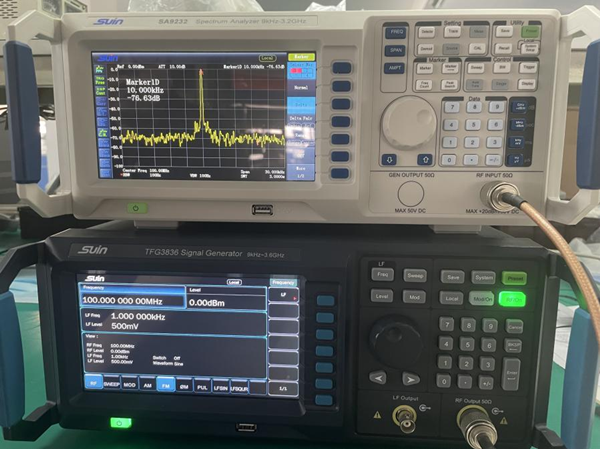How to Measure Phase Noise by Spectrum Analyzer
How to Measure Phase Noise by Spectrum Analyzer
Phase noise refers to the random changes in the phase of the system output signal caused by various noises in the system (such as various RF devices). It is an important index to measure the frequency stability quality of the frequency standard source (highly stable crystal oscillator, atomic frequency standard, etc.). With the improvement of the frequency standard source performance, the corresponding noise is getting smaller and smaller, so the measurement requirements of the phase noise are getting higher and higher.
Below is the introduction to how to use spectrum analyzer SA9232 and RF signal generator TFG3836 to measure phase noise.
Test Methods:
Set RF signal generator TFG3836: frequency to 100MHz and amplitude to 0dBm.
Then set the spectrum analyzer,press【FREQ】firstly to set the center frequency to 100MHz, then press【SPAN】to set the span to 30KHz, and press【BW】to set the RBW to 100Hz.
Set the delta by pressing 【Marker】, and select Delta to 10KHz.
Below is a picture of the measurement.
Recommended article:What is the purpose of a gas valve?
Unlocking Insights: Mastering the Freq Analyzer Tool
Key Questions to Consider When Choosing a Digital Marketing Tool
What Are the Best Mpi Accessories for You?
Are UV LED Lamps Revolutionizing Non-Destructive Testing Efficiency and Safety?
How to Use Api Rp 2x Effectively?
Unveiling Ultrasonic Flaw Detection: Top FAQs Answered!

Figure 1. Phase Noise Measurement
From figure 1 we can read that the amplitude difference(△A) is -76.63dB.
According to the phase noise calculation formula: phase noise=△A-10logRBW, we can get the phase noise of this signal as -96.63dB.
Mastering the Film Tensile Test ASTM: A Complete Guide
Are You Prepared for Sudden Load Surges with Board Bursting Testing?
How Can Pressure Decay Leak Testers Revolutionize Quality Control?
Exploring Popular Applications of Texture Analyzers
How to Use a Syringe Needle Penetration Tester?
Exploring Ndt UV LED Lamp Applications and Benefits
Say Goodbye to Product Loss: The Ultimate Solution for Pouch Burst Testing
None
None
Related Articles



Comments